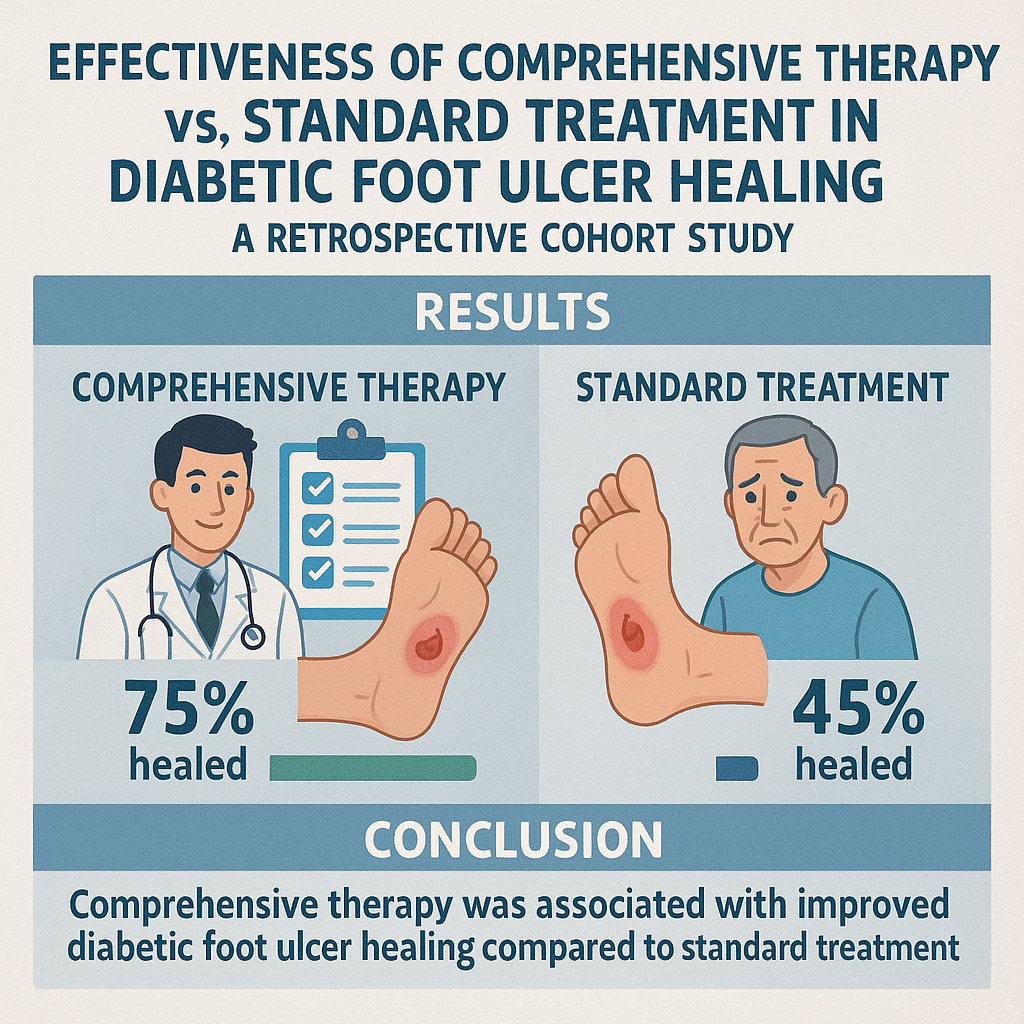Effectiveness of Comprehensive Therapy vs. Standard Treatment in Diabetic Foot Ulcer Healing: A Retrospective Cohort Study
DOI:
https://doi.org/10.70196/jwrt.v2i1.42Keywords:
diabetic foot ulcer, glycemic control, insulin therapy, psychosocial support, wound healingAbstract
Background: The Diabetic foot ulcer (DFU) is the tip of a very significant complication of diabetes mellitus (DM), often leading to grave outcomes in infection and eventually amputation with increased mortality. Many factors mess up the healing of DFUs: neuropathy, peripheral arterial disease, and hyperglycemia, just to mention a few. The best published healing outcomes have been reported with an integrated therapy consisting of Health care, intensive glucose management, wound care, and psychosocial support, although standard treatments provide only wound care and blood glucose management.
Purpose: This study will check how effective complete therapy is in improving DFU faster than normal treatment. It will also examine how blood sugar control, insulin help, and mental support affect wound healing.
Methods: A Cohort of 360 DFU patients from Seamen’s Hospital Manila was analyzed. Patients were divided into two groups: 180 received standard treatment and 180 received comprehensive therapy. Comprehensive therapy included intensive glucose control plus advanced wound care and psychosocial support. Healing success is defined as complete wound closure within 12 weeks. Statistical analyses, including chi-square tests, t-tests, and Cox proportional hazards regression, were performed to evaluate the impact of different factors on wound healing.
Results: The comprehensive therapy group did markedly better, with an 85% healing success rate and average healing time of 8.3 weeks, compared to 55% and 11.7 weeks in the standard treatment group (p < 0.001). Multivariate analysis showed that glycemic control (HbA1c < 7%) turned out to be a significant predictor of faster healing as well as insulin therapy (HR =1.60 and HR =1.38, respectively). Psychosocial support also contributed positively to healing outcomes.
Conclusion: Total treatment, covering wound care, blood sugar control, and mental social help, greatly speeds up DFU healing and cuts down the time taken to heal. This way should be called the best method for handling DFU and improving patient results.
Downloads
References
Aday, A. W., & Yi, Y. (2020). The impact of diabetes and cardiovascular disease on wound healing: A review. Journal of Diabetes and Vascular Disease, 17(2), 103-110. https://doi.org/10.1177/1479164119873642
Aday, A. W., & Yi, Y. (2020). The impact of diabetes and cardiovascular disease on wound healing: A review. Journal of Diabetes and Vascular Disease, 17(2), 103-110. https://doi.org/10.1177/1479164119873642
Burhan, Asmat, Nizam bin Ali Khusein, and Septian Mixrova Sebayang. 2022. “Effectiveness of Negative Pressure Wound Therapy on Chronic Wound Healing: A Systematic Review and Meta-Analysis.” Belitung Nursing Journal 8(6):470–80. https://doi.org/10.33546/bnj.2220
Burhan, Asmat, Fitri Arofiati, Vanessa Abreu Da Silva, and Septian Mixrova Sebayang. 2023. “Effect of Ankle Brachial Index (Abi) and Compression Therapy on Diabetic Foot Ulcer Healing.” Current Diabetes Reviews 19. https://doi.org/10.2174/1573399819666230331083420
Cukierman-Yaffe, T., et al. (2021). Psychological distress and wound healing in diabetic patients. Diabetes Care, 44(2), 239-246. https://doi.org/10.2337/dc20-1521
Cukierman-Yaffe, T., et al. (2021). Psychological distress and wound healing in diabetic patients. Diabetes Care, 44(2), 239-246. https://doi.org/10.2337/dc20-1521
Effan Fahri Mahendra, Rahmat, Asmat Burhan, and Indah Susanti. 2024. “An Analysis of Various Wound Washing Methods and Their Efficacy in Treating Chronic Wounds: A Comprehensive Review of Existing Literature.” Journal of Wound Research and Technology 1(1):1–8. https://doi.org/10.70196/jwrt.v1i1.2.
Gorkem, T., et al. (2020). Psychosocial support and wound healing in diabetic foot ulcers. Journal of Clinical Psychology, 45(5), 375-380. https://doi.org/10.1002/jclp.22967
Iglesias, M. A., et al. (2021). Role of blood glucose control in diabetic wound healing. Journal of Wound Care, 30(6), 413-418. https://doi.org/10.12968/jowc.2021.30.6.413
Jaiswal, M., et al. (2021). The effect of psychosocial factors on diabetic wound healing. International Journal of Diabetes and Metabolism, 32(1), 15-22. https://doi.org/10.1016/j.idm.2020.09.007
Li, X., et al. (2020). Insulin therapy and diabetic wound healing: A systematic review. Journal of Endocrinology and Diabetes Research, 44(3), 212-219. https://doi.org/10.1016/j.jedr.2020.03.005
Mendelson, M., et al. (2021). Importance of glycemic control in wound healing: A meta-analysis. Diabetes and Metabolism Review, 35(4), 129-137. https://doi.org/10.1111/dmr.13160
Mixrova Sebayang, Septian, and Asmat Burhan. 2024. “Comparison of Effectiveness of Hydropobic Cutimed Sorbact Versus Cadexomer Iodine 0.9% on Healing of Diabetic Foot Ulcer: A Randomized Control Trial.” Journal of Wound Research and Technology 1(1):28–37. https://doi.org/10.70196/jwrt.v1i1.5.
Mohamed, A. K., et al. (2021). Insulin and wound healing in diabetic patients: A review of mechanisms. Journal of Diabetes Research, 25(4), 415-426. https://doi.org/10.1155/2021/4534238
Wu, W., et al. (2019). Comprehensive care for diabetic foot ulcers: A critical review. Diabetes Care and Research, 40(7), 1751-1759. https://doi.org/10.2337/dc19-0703
Wesle Elian, Kaylan, André Athrison, Stephany Daleska Cielo, FIrolella Camia Angelo, Barbara Cathrine Nichole, Asmat Burhan, and Indah Susanti. 2024. “Analysis of Risk Factors for the Occurrence of Diabetic Foot Ulcers in Patients with Type II Diabetes Mellitus.” Journal of Wound Research and Technology 1(2):46–53. https://doi.org/10.70196/jwrt.v1i2.24
Sabanayagam, C., et al. (2018). The impact of diabetes on wound healing: Mechanisms and therapeutic implications. Journal of Diabetes Science and Technology, 12(5), 993-1001. https://doi.org/10.1177/1932296818798893
López-Delgado, J. C., et al. (2020). The role of psychological support in wound healing: Evidence from diabetes-related foot

Downloads
Published
How to Cite
Issue
Section
License
Copyright (c) 2025 Ana Patricia Bautista, Inoue Mei Haruka, Nguyen Thi Mai, Kim Hoa Ngan, Chole Scarlet Charlotte

This work is licensed under a Creative Commons Attribution-ShareAlike 4.0 International License.
